Quadropolis: Build your own city from an ever-decreasing pool of buildings.
But don’t point at the Mayor!
Each player builds their own metropolis in Quadropolis, but they’re competing with one another for the shops, parks, public services and other structures to be placed in them.
In this, you will take buildings from a shared central board to place on your own player board to score points for adjacency, building use and height.
This game has 2 options, Classic and Expert. Both play similarly but different enough it’s worth mentioning. I’ll go through the Classic game first, then add a section at the end to let you know what Expert does differently.
Quadropolis Classic Mode
The game is played over 4 rounds. Each round has its own number of tiles that are added to the main board, randomly. Then you flip up those that will be used for the player count. This means there will be some randomly placed face-down tiles in a 2 or 3-player game.
Each player has 4 architects of their colour numbered 1 to 4.
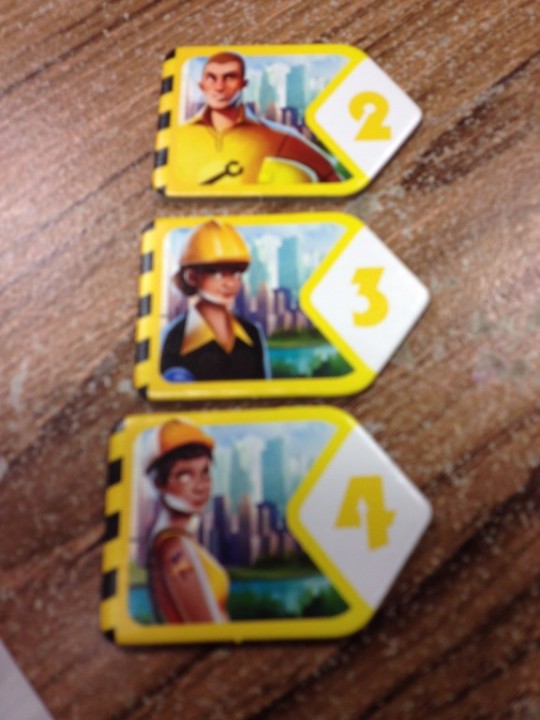
You pick one of them and point it onto the main board.
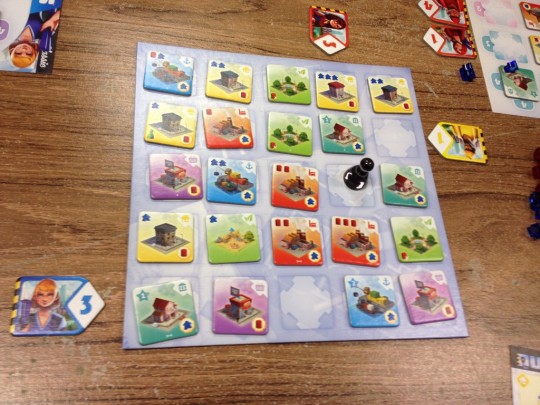
You can point it from any side of the board and you take the tile that is that number of spaces in. In this case, the Blue 3 architect (bottom left) took the tile 3 spaces along. When you pick up a tile you put the Black Mayor pawn in its place and the next player can not point their architect at it, restricting a row and column.
Playing a Tile
The architect also shows where you can play the tile on your player board.
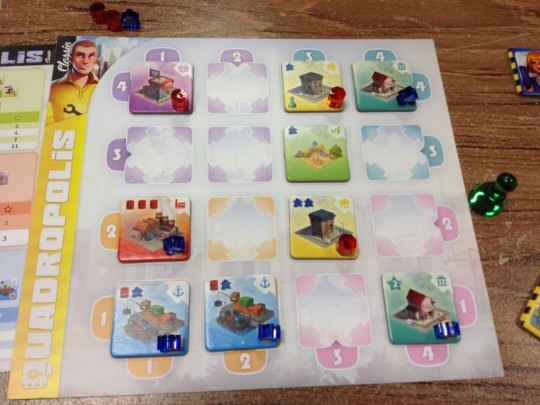
In the above example, as the Blue player used their number 3 architect, they must put it in any square on Row 3, or column 3 of their board.
The exception to this is the Tower Blocks as they can be built upwards. The ground floor works the same way as any other tile but additional floors are played per level. If you use your 2 Architects to get a Tower block tile, you can place it as normal. Or, in a break with the usual rules, you can use it to build the 2nd floor of a pre-existing Tower Block (Architect 3 does the 3rd floor etc) You can also place it as a second floor as normal on top of another Tower Block tile.
The top left of each tile shows you your income. You get a number of Meeples or Energy, or sometimes some of each. The bottom right of each tile shows you how many of these 2 resources you need to activate if any.
Once everyone has played their 4 architects you set up for round 2 and repeat. After 4 rounds the game ends and you score.
Each building type has its own way of scoring. it’s worth noting that any Meeples of Energy tokens you gained that you can’t use count as -1 point each.
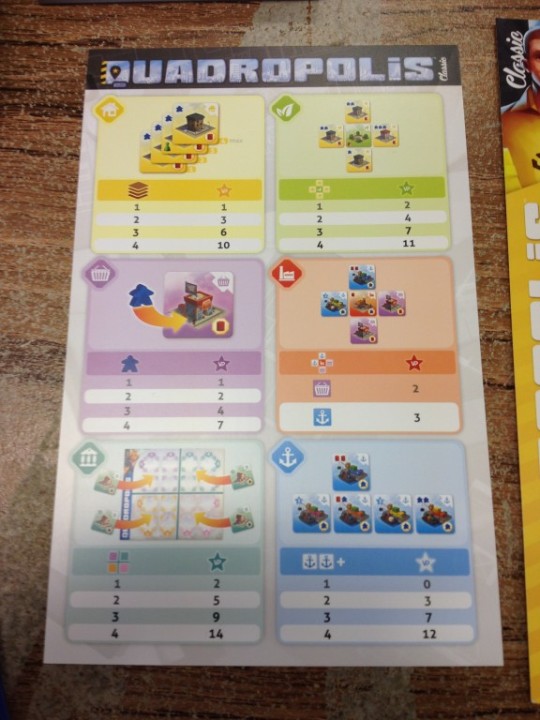
Buildings
Tower Blocks – These score points per floor so the higher the better.
Shops – Can contain up to 4 customers and gain points per customer they have in the shop. This is a good way of dumping additional Meeples at the end of the game to avoid any penalty.
Public Services – Need to be spread out and you score more points if you have them in different districts.
Parks – Score points for being next to Tower Blocks but also most can absorb up to 1 spare energy each, allowing you to avoid penalty points.
Factories – You get points for adjacent to harbours and shops.
Harbours – These need to be in a row or column and you score for the largest straight row and longest column you have.
Most points win.
Quadropolis Expert Mode
What’s different?
There is a 5th round.
Each player has a shared pool of Architects numbered 1 to 5. There is one of each number per player. We played a 3 player game so had 15 architects.
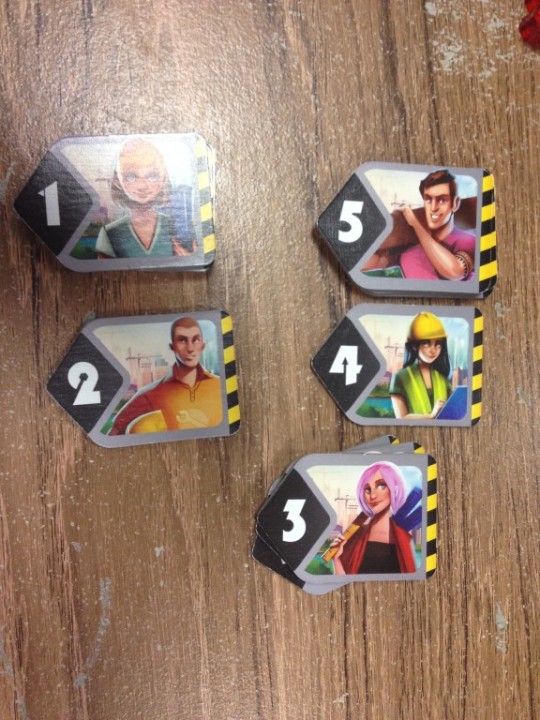
On your turn, you pick from any of those available.
You have 5 districts on your board each with 4 spaces but each District uses all 5 numbers. For example, District 1 has spaces numbered 2,3,4 and 5. So if you played a 1 Architect, you can put it in ANY square numbered 1 in any District or any Square within District 1.
There is an extra tile type, Office Towers, which can also stack in the same way Tower Blocks do.
Each group of adjacent Office Blocks is scored based on the number in that group. The larger the group, the more points each Office Block is and each Block is scored on the number of floors.
There are also Monuments which score points depending on adjacent buildings.
Summary
Quadropolis is made by Days of Wonder who did Five Tribes and the vibe is very similar. It’s very pretty, has nice components, easy to teach, easy to play and the best player will win.
Those numbers…
You have to look at the board, see which tile you can get and where you can play it. This isn’t slow like Five Tribes can be though so no worries there.
You quite often can get the tile you want but not put it where you need it or vice versa. It’s not random or luck based though, at least it doesn’t feel that way.
The Classic and Expert games are different enough that you can enjoy both at different times. In a lot of games, once you hit expert you don’t go back (except to teach new players) but this will knock 10-15 mins off the length of the game without changing it a whole deal.
The restriction on your Architects in Classic is different to Expert so it involves a different way of thinking.
Overall Quadropolis is a very good game that I hope to play a lot more. Will I still be thinking that in a year? Maybe, maybe not, we’ll see 🙂
Jesta ThaRogue
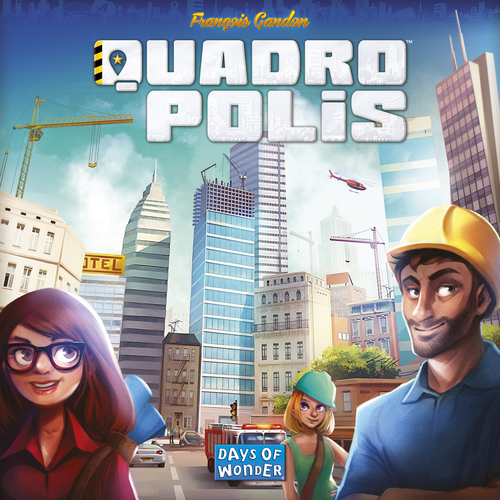


Leave a Reply